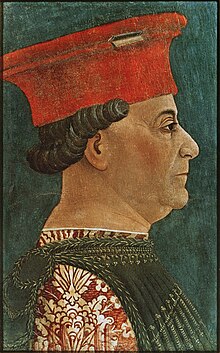Our website is made possible by displaying online advertisements to our visitors.
Please consider supporting us by disabling your ad blocker.
Francesco I Sforza
| Francesco I Sforza | |
|---|---|
 Portrait of Francesco Sforza (c. 1460) by Bonifacio Bembo. Sforza insisted on being shown in his worn dirty old campaigning hat. Pinacoteca di Brera, Milan. | |
| Duke of Milan | |
| Reign | 25 March 1450 – 8 March 1466 |
| Predecessor | Golden Ambrosian Republic |
| Successor | Galeazzo Maria Sforza |
| Born | 23 July 1401 Cigoli, San Miniato, Republic of Florence |
| Died | 8 March 1466 (aged 64) Milan, Duchy of Milan |
| Spouse | Polissena Ruffo Bianca Maria Visconti |
| Issue | Galeazzo Maria Sforza, Duke of Milan Ippolita Maria Sforza, Duchess of Calabria Filippo Maria Sforza, Count of Corsica Sforza Maria Sforza, Duke of Bari Francesco Galeazzo Maria Sforza Ludovico Sforza, Duke of Milan Ascanio Maria Sforza Elisabetta Maria Sforza, Marquise of Montferrato Ottaviano Maria Sforza, Count of Lugano |
| House | Sforza |
| Father | Muzio Attendolo Sforza |
| Mother | Lucia de Martini (Demartini) |


Francesco I Sforza KG (Italian: [franˈtʃesko ˈpriːmo ˈsfɔrtsa]; 23 July 1401 – 8 March 1466) was an Italian condottiero who founded the Sforza dynasty in the duchy of Milan, ruling as its (fourth) duke from 1450 until his death.
In the 1420s, he participated in the War of L'Aquila and in the 1430s fought for the Papal States and Milan against Venice. Once the war between Milan and Venice ended in 1441 under mediation by Sforza, he successfully invaded southern Italy alongside René of Anjou, pretender to the throne of Naples, and after that returned to Milan. He was instrumental in the Treaty of Lodi (1454) which ensured peace in the Italian realms for a time by ensuring a strategic balance of power. He died in 1466 and was succeeded as duke by his son, Galeazzo Maria Sforza. While Sforza was recognized as duke of Milan, his son Ludovico would be the first to have formal investiture under the Holy Roman Empire by Maximilian I in 1494.
Previous Page Next Page


